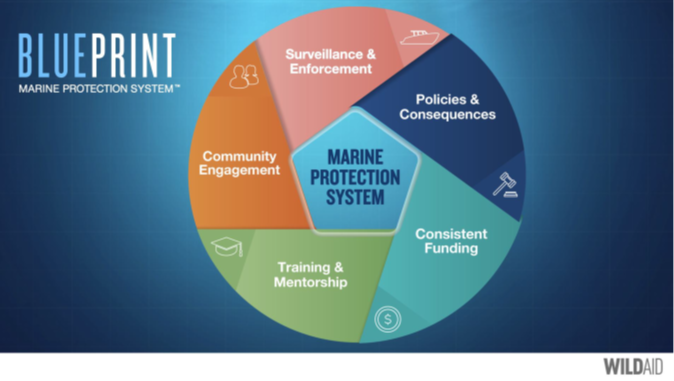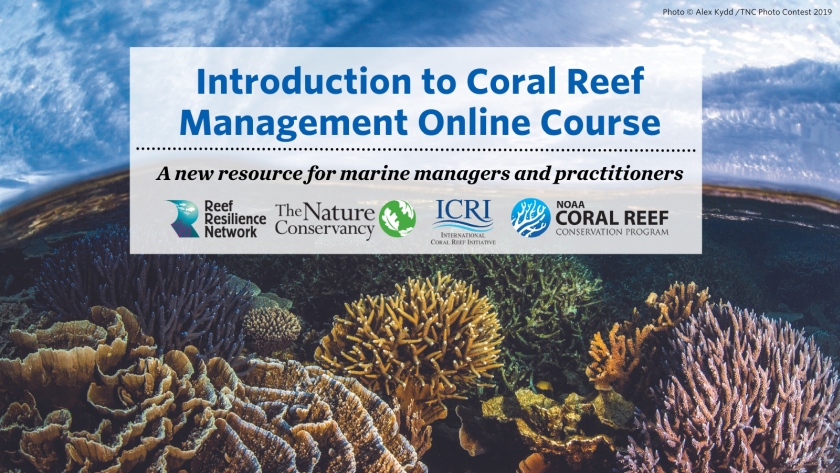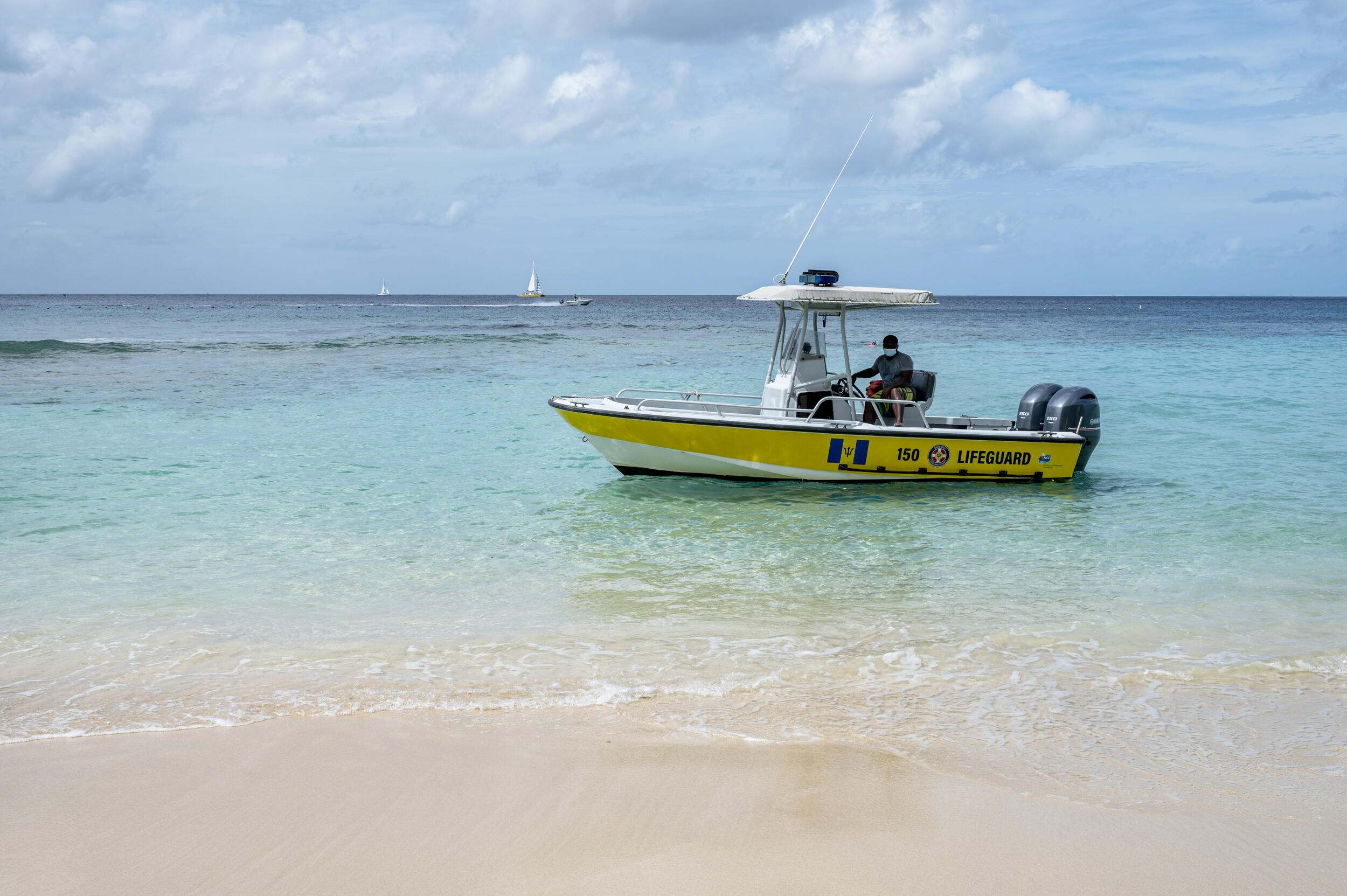The Marine Action Partnership (MAP) – A Collaborative Approach to Improve Sustainable Fishing in The Bahamas
Location
The Bahamas
The challenge
Enforcement of marine protected areas (MPAs) is a challenge worldwide due to a lack of resources; 60 percent of MPAs worldwide are not well enforced. The Bahamas Exclusive Economic Zone (EEZ) is the largest in the Caribbean, containing over 242,000 square miles of protected ocean and islands, which presents a huge challenge for enforcement. In 2011, The Bahamas designated its waters as a shark sanctuary, following the banning of commercial longline fishing in 1993 which provided initial protection for sharks and other bycatch. Effective marine management and enforcement are essential for maintaining healthy and sustainable fisheries, ensuring The Bahamas’s economic and ecological sustainability.
Enforcement challenges include not only the large size of the protected area, but also limited capacity to deter foreign vessels from illegal fishing. Currently, nearly one-third of all fishing catch in The Bahamas is considered illegal, unreported, and unregulated (IUU) fishing. ref IUU fishing in The Bahamas often targets vulnerable resources including spiny lobster, conch, reef fish, and sharks, threatening the economy and marine ecosystems. IUU fishing pressures come from a variety of sources, including the Bahamian fishing fleet, fishing fleets from neighboring countries as well as distant foreign nations, and American recreational vessels. ref
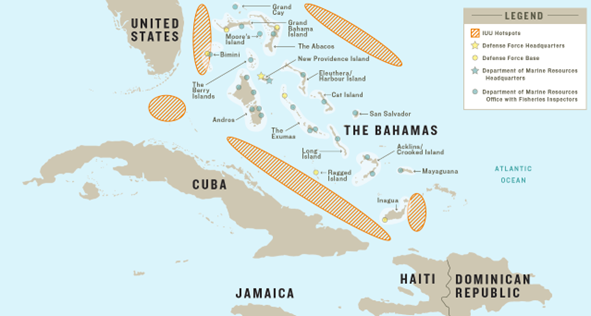
Map of illegal fishing hotspots in the Bahamas EEZ and enforcement infrastructure. Source: The Bahamas Marine Protection System Blueprint
Fisheries are vital to The Bahamas economy, providing livelihoods for tens of thousands of fishers and contributing US$1.24 billion to the country’s gross domestic product. Further, The Bahamas’ shark diving industry is valued at more than US$110 million per year. ref IUU fishing is estimated to cost The Bahamas over US$135 million, or approximately 11 percent of fisheries’ contributions to The Bahamas’s gross domestic product annually.
Actions taken
To address the challenge of monitoring, control, surveillance, and enforcement within The Bahamas’ maritime domain, Bahamian government agencies partnered with WildAid and The Nature Conservancy (TNC) in 2018 to form the Marine Action Partnership (MAP) for Sustainable Fisheries. This multiagency initiative enhances collaboration to improve marine patrols, surveillance, investigation, and public outreach. Activities under the MAP include:
- Conducted an enforcement gap assessment and developed a comprehensive Marine Protection System plan in 2021 (The Bahamas Marine Protection System Blueprint) to address gaps and opportunities for enhancing patrol, surveillance, and investigation techniques and processes. The Marine Protection System Blueprint provides a design for an effective enforcement and compliance system for The Bahamas EEZ.
- Convened a workshop in 2021 to develop a strategic action plan focused on improvements in five key areas: (1) strengthening policies and consequences, (2) community engagement, (3) enforcement and surveillance, (4) training and mentorship, and (5) ensuring long-term consistent funding. Specific agencies lead each of the thematic action areas with support from other agencies in the MAP.
- Coordinate annual planning meetings to prioritize action items and coordinate efforts. These meetings provide the time and space for evaluating previous commitments, discussing agency efforts, and seeking opportunities for collaboration and cooperation (e.g., development of policies, selection of uniforms, and technology testing/selection).
- Develop and implement recommendations for training law enforcement officers, resource managers, lawyers, and other roles, including creation of dedicated peer-to-peer exchanges and regional workshops.
A memorandum of understanding (MOU) signed in October 2022 formally established long-term cooperation between WildAid, The Bahamas’ Ministry of National Security, The Bahamas Department of Marine Resources, the Royal Bahamas Defence Force (RBDF), The Bahamas National Trust, TNC, and other stakeholders. This Bahamas interagency MOU is unique in terms of the comprehensive coordination structure it provides. The MOU commits resources toward enhancing patrol and investigative strategy, inter- and intra-agency coordination, policy and procedures development, training and mentorship, tool acquisition and maintenance, education and outreach. ref
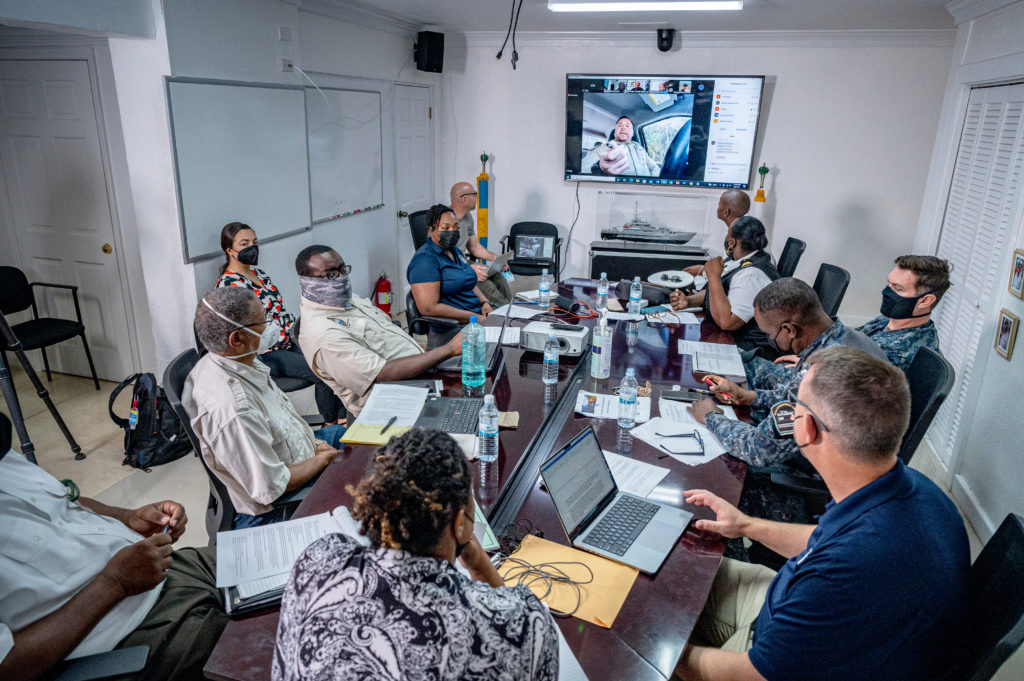
Initial meetings among agencies to improve communication and cooperation and better enforce fisheries laws in The Bahamas using the MAP Plan. Photo © Shane Gross / iLCP
How successful has it been?
Through the MAP, The Bahamas has advanced toward the goals of reducing IUU fishing and increasing marine regulatory compliance in its EEZ. While interagency partnerships existed before, the MAP governance structure provides a mechanism for greater coordination on efforts to enhance compliance and enforcement. Accomplishments of the MAP include:
- Successful investigation and prosecution of various high-profile fisheries crimes. Between 2021 – 2023, joint efforts between U.S. and Bahamian authorities resulted in seizure of hundreds of pounds of illegal catch, as well as the forfeiture of a boat now employed as a new patrol boat by the RBDF. ref In addition, two international illegal fishing vessels were penalized with $1.9M in fines.
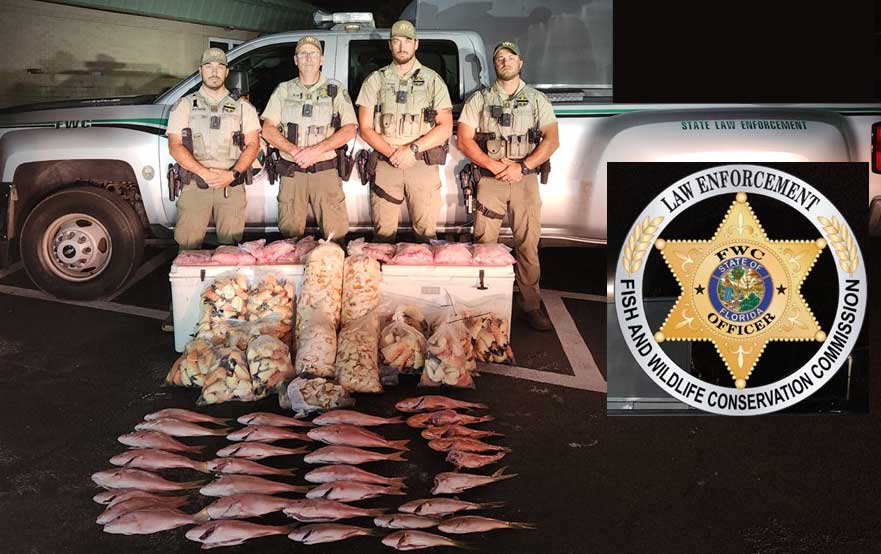
Based on intelligence information provided by Bahamian officers, Florida Fish and Wildlife Conservation Commission officers intercepted a vessel returning from the Bahamas with nearly 300 pounds of illegally imported queen conch and stone crab. Photo © Florida Fish and Wildlife Conservation Commission
- Receipt of the Stop IUU Fishing Award in 2023. The award recognizes national and regional fisheries monitoring, control, surveillance, compliance, and enforcement activities that demonstrate creativity, success, and have real impacts.
- Formation of the Bahamas Wildlife Enforcement Network (BAHWEN)—a focused fish and wildlife enforcement entity—which has already succeeded in working with Non-governmental organizations to secure funding for priority equipment.
- Reports of revitalized fish stocks in the northern and southern waters of The Bahamas due to increased patrols.
- Training for members of BAHWEN in advanced investigative techniques including post-event illegal fish and wildlife harvest and trafficking investigation.
- Increased collaboration among Bahamian and U.S. law enforcement agencies, including conducting a tabletop exercise between the two countries to combat international IUU.
In particular, training interactions enabled through the MAP have improved bonds between the agencies, improving understanding of what each agency does, and encouraged and enhanced collaboration efforts.
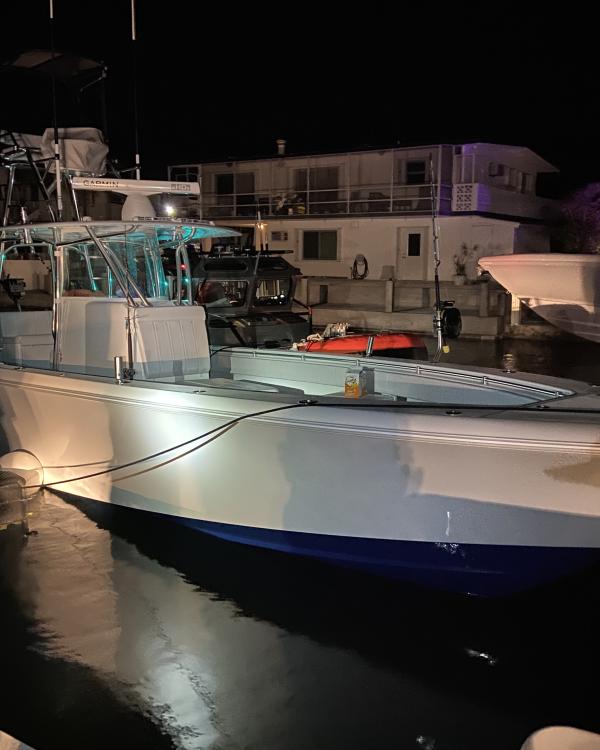
The fisherman who plead guilty to illegal fishing in The Bahamas offered new boat as restitution. Photo © NOAA Fisheries
Lessons learned and recommendations
The scale of protected marine areas in The Bahamas, combined with the overarching goal of controlling IUU fisheries while supporting legal fisheries, and the involvement of multiple government agencies with marine enforcement responsibilities, complicated the establishment of a comprehensive Marine Protection System in The Bahamas. Issues include bureaucratic challenges to coordination, intelligence-sharing constraints, and limited assets. To overcome these challenges, key considerations for developing a successful Marine Protection System include:
- Success in combatting IUU fishing requires coordination and collaboration across local, national, and international levels.
- Building meaningful interagency partnerships, such as the MAP, at the national level is critical. The political will to form the multi-agency MOU formalizing the MAP was instrumental. The MOU demonstrated and clarified the government’s commitment with specific action items.
- Trainings involving multiple agencies provide a means for opening channels of communication while enabling networking with counterparts from other countries.
- It is important to establish a protocol for whole government response to fisheries crime, including defining roles (e.g., enforcement, detection, prosecution, and evidence preservation). Formation of BAHWEN helped consolidate the enforcement goals and establish formal means for collaboration at the national level.
- While the WildAid Marine Protection System Blueprint is replicable, a Marine Protection System should be tailored to consider local conditions, while maintaining a strong enforcement framework.
Funding summary
Funding for the MAP includes significant contributions from the various government agencies who contribute personnel time and equipment for training, coordination, and law enforcement operations. TNC and WildAid contributed funding for training and participation by their staff.
Collaborators
The Nature Conservancy Northern Caribbean Program
The Bahamas Department of Marine Resources
Bahamas Wildlife Enforcement Network
Bahamas Customs & Excise Department
NOAA Fisheries Office of law Enforcement
Florida Fish and Wildlife Commission
Resources
WildAid Bahamas Project Description
RBDF presentation – Bahamas Approach to IUUF, International Monitoring, Control and Surveillance Network
The Bahamas Marine Protection System Blueprint
Ministry of National Security press release on MAP MOU
Marine Action Partnership International League of Conservation Photographers (iLCP) video
Blue Charters Webinar: From Policy to Practice – Marine Action Partnership and Sustainable Coastal Fisheries Management
Blue Charter Webinar news release: https://thecommonwealth.org/news/experts-say-marine-law-enforcement-can-revolutionise-marine-conservation-create-jobs-and-feed

